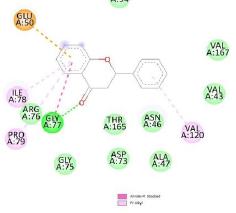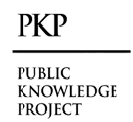Molecular Docking of Some Phytochemicals Against DNA Gyrase of Gram-Negative and Gram-positive Bacteria
Keywords:
Phytochemicals, DNA Gyrase, Molecular DockingAbstract
Molecular docking is a computational technique that predicts the binding orientation and affinity of a small molecule (ligand) to a target macromolecule (receptor). It involves the calculation of the intermolecular interactions between the ligand and receptor to estimate the binding energy and to identify the most stable and favorable binding conformation. Molecular docking can be used for drug discovery and design, as it can help identify potential drug candidates that bind to a specific target with high affinity and selectivity. It is also widely usedin structural biology, as it can provide insights into the structural basis of ligand- receptor interactions. The objective of this study was to investigate the potential activity of various phytochemicals against DNA gyrase of Escherichia coli and Staphylococcus aureus, using molecular docking technique. The study involved 43 phytochemical compounds, along with Ciprofloxacin and Nalidixic acid. The 3D structures of these compounds were obtained from PubChem database and prepared using PyRx-Vina Program 0.8 and OpenBabel software version 3.1.1. DNA gyrase of E. coli (ID 7P2M) and S. aureus (ID 3U2D) were obtained from the RCSB PDB database and refined through energy minimization using the PyRx-Vina Program 0.8. According to the binding affinity values, the results indicated that Diospyrinwas the most active compound against DNA gyrase of E. coli (-8.7) and S. aureus (-9.1), while Imidazoline was the least active against DNA gyrase of E. coli (-3) and Allyl methyl disulfide was the least active against DNA gyrase of S. aureus (-3) when compared with Ciprofloxacin and Nalidixic acid. The study also revealed that the number of amino acids that interacted with each compound varied. The findings suggest that phytochemical compounds could beused as potential antibacterial agents, and further in-vitro and in-vivo studies are recommended using the most active compounds.
Downloads
References
Chanda, S., & Ramachandra, T. (2019). A review on some Therapeutic aspects of Phytochemicals present in
Medicinal plants. International Journal of Pharmacy & Life Sciences, 10(1).
Dallakyan, S., & Olson, A. J. (2015). Small-molecule library screening by docking with PyRx. Chemical
biology: methods and protocols, 243-250.
Degfie, T., Endale, M., Tafese, T., Dekebo, A., & Shenkute, K. (2022). In vitro antibacterial, antioxidant
activities, molecular docking, and ADMET analysis of phytochemicals from roots of Hydnora johannis.
Applied Biological Chemistry, 65(1), 1-13.
Didierjean, C., & Tête-Favier, F. (2016). Introduction to Protein Science. Architecture, Function and Genomics.
By Arthur M. Lesk. Oxford University Press, 2016. Pp. 466. Paperback. Price GBP 39.99. ISBN
Acta Crystallographica Section D: Structural Biology, 72(12), 1308-1309.
Frickmann, H., Hahn, A., Berlec, S., Ulrich, J., Jansson, M., Schwarz, N. G., Warnke, P., & Podbielski, A.
(2019). On the etiological relevance of Escherichia coli and Staphylococcus aureus in superficial and deep
infections–a hypothesis-forming, retrospective assessment. European Journal of Microbiology and
Immunology, 9(4), 124-130.
George, B. P., Chandran, R., & Abrahamse, H. (2021). Role of phytochemicals in cancer chemoprevention:
Insights. Antioxidants, 10(9), 1455.
Hadi, I., Irawan, A., Ulfah, M., Putra, T. A., Efriani, L., Haq, M. I., & Purnama, M. R. (2022). Potential of
Several Phytochemicals of Mangrove Species (Rhizopora stylosa) as Inhibitor of Both Viral Gene Expression
and Bacterial Nucleic Acid Synthesis. Jurnal Ilmu Kesehatan, 10(1), 81-88.
Hobson, C., Chan, A. N., & Wright, G. D. (2021). The antibiotic resistome: a guide for the discovery of natural
products as antimicrobial agents. Chemical Reviews, 121(6), 3464-3494.
Hueso-Falcón, I., Amesty, A., Anaissi-Afonso, L., Lorenzo-Castrillejo, I., Machin, F., & Estévez-Braun, A.
(2017). Synthesis and biological evaluation of naphthoquinone- coumarin conjugates as topoisomerase II
inhibitors. Bioorganic & Medicinal Chemistry Letters, 27(3), 484-489.
Karkare, S., Chung, T. T., Collin, F., Mitchenall, L. A., McKay, A. R., Greive, S. J., Meyer, J. J., Lall, N., &
Maxwell, A. (2013). The naphthoquinone diospyrin is an inhibitor of DNA gyrase with a novel mechanism of
action. Journal of Biological Chemistry, 288(7), 5149-5156.
Kato, F., Yamaguchi, Y., Inouye, K., Matsuo, K., Ishida, Y., & Inouye, M. (2022). A novel gyrase inhibitor
from toxin–antitoxin system expressed by Staphylococcus aureus. The FEBS Journal.
Maden, S. F., Sezer, S., & Acuner, S. E. (2022). Fundamentals of Molecular Docking and Comparative
Analysis of Protein–Small-Molecule Docking Approaches. In Molecular Docking-Recent Advances.
IntechOpen.
Mandal, S. K., & Munshi, P. (2021). Predicting Accurate Lead Structures for Screening Molecular Libraries: A
Quantum Crystallographic Approach. Molecules, 26(9), 2605.
Menchaca, T. M., Juárez-Portilla, C., & Zepeda, R. C. (2020). Past, present, and future of molecular docking.
In Drug Discovery and Development-New Advances. IntechOpen.
Meng, X.-Y., Zhang, H.-X., Mezei, M., & Cui, M. (2011). Molecular docking: a powerful approach for
structure-based drug discovery. Current computer-aided drug design, 7(2), 146-157.
Mohamady, S., Gibriel, A. A., Ahmed, M. S., Hendy, M. S., & Naguib, B. H. (2020). Design and novel
synthetic approach supported with molecular docking and biological evidence for naphthoquinonehydrazinotriazolothiadiazine
analogs as potential anticancer inhibiting topoisomerase-IIB. Bioorganic
chemistry, 96, 103641.
Pullella, G. A., Vuong, D., Lacey, E., & Piggott, M. J. (2020). Total Synthesis of the Antitumor–Antitubercular
, 6′-Bijuglone Natural Product Diospyrin and Its 3, 6′- Isomer. Journal of Natural Products, 83(12), 3623-
Rajeswari, R. (2018). Synthesis, Characterization, Molecular Docking Studies of Substituted 2-Amino 3-
Chloro Naphthoquinone Derivatives and their Pharmacological Assessment JKK Nattraja College of Pharmacy,
Komarapalayam].
Ramalho, T. C., Caetano, M. S., da Cunha, E. F., Souza, T. C., & Rocha, M. V. (2009). Construction and
assessment of reaction models of class I EPSP synthase: molecular docking and density functional theoretical
calculations. Journal of Biomolecular Structure and Dynamics, 27(2), 195-207.
Raval, K., & Ganatra, T. (2022). Basics, types and applications of molecular docking: a review. IP International
Journal of Comprehensive and Advanced Pharmacology, 7(1), 12-16.
Salmaso, V., & Moro, S. (2018). Bridging molecular docking to molecular dynamics in exploring ligandprotein
recognition process: An overview. Frontiers in pharmacology, 9, 923.

Downloads
Published
How to Cite
Issue
Section
License

This work is licensed under a Creative Commons Attribution 4.0 International License.
Current Clinical and Medical Education













